The 2015 Smithsonian Institution article, “Putting Archival Audiovisual Media into Context: An Archival Approach to Processing Mixed-Media Manuscript Collections” by Megan McShea, provided insight into the practices of processing, arrangement, and accessibility for audiovisual materials. A key element was delving into the value of “traditional processing workflows” that offered structure to planning and guidelines. The objective: “unlocking the content” of these records.
The term of “audiovisual” affords a differentiation between written records and nontextual media. The SAA Dictionary of Archives Terminology outlines “audiovisual” as media with “sound and pictorial attributes.” In a mixed-media collection, like-materials are housed together due to different condition requirement (acidity, preservation, reformatting, etc.). However, as McShea outlined, audiovisual materials should still be “effectively described in the aggregate” and not isolated from the collection completely.




The Irving Wallace Papers contain a variety of audiovisual materials including, VHS tapes, vinyl, cassettes, DVDs, illustrations, posters, photographs, and book cover proofs—all woven throughout the collection. An audiovisual item that I recently encountered was a 1987 audio cassette series of a recorded book reading for The Prize. Produced by the “Hear a Book” Service in Tasmania, Australia, this cassette series is narrated by Bobby Roberts. The book reading unfolds the story of The Prize as “an imaginative insight into the minds, motives, and morals of six fictional Nobel Prize winners.”
Stay tuned, Chelsea Fox
Works Cited
Dictionary of Archives Terminology. SAA: Society of American Archivists, 2025. https://dictionary.archivists.org/entry/audiovisual.html
McShea, Megan. “Putting Archival Audiovisual Media into Context: An Archival Approach to Processing Mixed-Media Manuscript.” Archives of American Art, Smithsonian Institution, 2016. https://www.clir.org/wp-content/uploads/sites/6/McShea.pdf